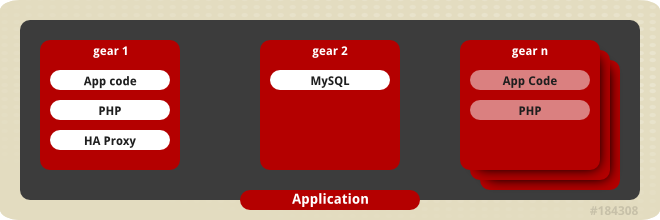-
Language:
English
-
Language:
English
Chapter 10. Applications
10.1. Introduction to Applications
~/.ssh/known_hosts directory.
Table 10.1. Application Components
| Component | Description |
|---|---|
| Domain | The domain provides a unique group identifier for all the applications of a specific user. The domain is not directly related to DNS; instead, it is appended to the application name to form a final application URL of the form http://App_Name-domain.example.com |
| Application Name | The name of the application is selected by a user. The final URL to access the application is of the form http://App_Name-domain.example.com |
| Alias | DNS names can be provided for the application by registering an alias with OpenShift Enterprise and pointing the DNS entry to the OpenShift Enterprise servers. |
| Git repository | A Git repository is used to modify application code locally. After the code is applied, the git push command is required to deploy the revised code. |
/var/tmp and /tmp directories for each user application. The /var/tmp directory is a symbolic link to /tmp. Each /tmp directory is completely isolated from the /tmp directories of all other applications. Files that are untouched for any period of ten days are automatically deleted from these directories.
10.1.1. Application Life Cycle
Table 10.2. Application Life Cycle
| Process | Description |
|---|---|
| Code | Develop the application code with the desired language and tools. Continuously push the application code to the applications remote Git source code repository. |
| Build | OpenShift Enterprise supports various build mechanisms, whether it is a simple script, a personal Jenkins continuous integration server, or an external build system. |
| Deploy | Every application is composed of cartridges that simplify server maintenance and configuration. OpenShift Enterprise supports various technologies to provision the required services automatically. |
| Manage | OpenShift Enterprise allows real-time monitoring, debugging, and tuning of applications. Applications are scaled automatically depending on web traffic. |
10.1.2. Scalable Applications
Each application created on OpenShift Enterprise must have one web framework cartridge defined upon creation. For example, a PHP cartridge. When an application is defined as scalable, a second cartridge, the HAProxy cartridge, is added to the application. The HAProxy cartridge listens to all incoming web-page requests to an application and passes them to the web cartridge, following the defined guidelines for load monitoring.

Figure 10.1. Cartridges on Gears in a Scaling Application
10.1.3. Highly-Available Applications
At this time of writing, the only way to enable high availability in applications is through the REST API. See Section 11.7, “Making Applications Highly Available” for the curl command to make your applications highly available, or the relevant section in the OpenShift Enterprise REST API Guide for more information:

